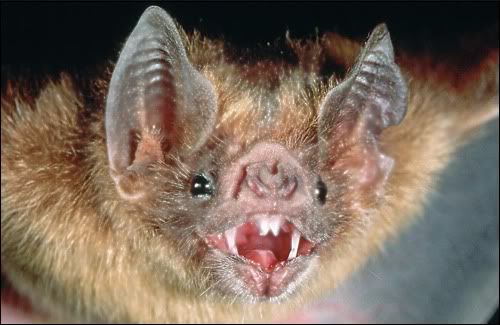|
|
Bat
Dec 20, 2009 10:14:34 GMT -5
Post by Revenge on Dec 20, 2009 10:14:34 GMT -5
Bats
Mosquito Catchers: Hollywood may have given bats a bad name, but the zigzag path of a bat against the night sky can mean only one thing, thousands of mosquitoes are about to meet their maker, thus lessening the chance of outbreaks of malaria in other animals including humans.
Fruit and Blood Eaters: Some species of bats also eat fruit and use their tongues to sip nectar. Carnivorous bats put lizards and frogs on the menu, and fish-eating bats have no trouble capturing a fish dinner with their hooked claws. The infamous vampire bat uses its sharp teeth to pierce the skin of animals for the liquid nourishment of blood.
Flapping Wings: Bats are the only mammal that can take to the sky on flapping wings. Wingspans range from over 5 feet in the fox bat to 6 inches in the hog-nosed bat. Many species of bat are found worldwide in tropical and temperate climates.
Seeing by Listening: In its nightly search for food, a bat's secret weapon is echolocation. Focusing on a tasty morsel, a clicking sound is emitted through its mouth or nose. The time it takes for the sound to return to the bat's highly receptive ears reveals the size and location of the object.
DID YOU KNOW?
Wings Across the World: Aside from the poles and extreme deserts, bats can be found in just about every corner of the world.
Our Cousin the Bat?: Humans may be more closely related to bats than previously thought. Recent studies indicate that Old World fruit bats and flying foxes may be descended from early primates.
Fourth of All Mammals: There are roughly 1,000 species of bat, making up a fourth of all mammal species. Most are small enough to fit inside a human's hand.
[/blockquote] |
|
|
|
Bat
Dec 20, 2009 10:46:36 GMT -5
Post by Revenge on Dec 20, 2009 10:46:36 GMT -5
The Common Vampire Bat
Common Vampire Bat Profile
Bats are the only mammals that can fly, but vampire bats have an even more interesting distinction—they are the only mammals that feed entirely on blood.
These notorious bats sleep during the day in total darkness, suspended upside down from the roofs of caves. They typically gather in colonies of about 100 animals, but sometimes live in groups of 1,000 or more. In one year, a 100-bat colony can drink the blood of 25 cows.
During the darkest part of the night, common vampire bats emerge to hunt. Sleeping cattle and horses are their usual victims, but they have been known to feed on people as well. The bats drink their victim's blood for about 30 minutes. They don't remove enough blood to harm their host, but their bites can cause nasty infections and disease.
Vampire bats strike their victims from the ground. They land near their prey and approach it on all fours. The bats have few teeth because of their liquid diet, but those they have are razor sharp. Each bat has a heat sensor on its nose that points it toward a spot where warm blood is flowing just beneath its victim's skin. After putting the bite on an animal, the vampire bat laps up the flowing blood with its tongue. Its saliva prevents the blood from clotting.
Young vampire bats feed not on blood but on milk. They cling tightly to their mothers, even in flight, and consume nothing but her milk for about three months.
The common vampire bat is found in the tropics of Mexico, Central America, and South America.
Common Vampire Bat Range (In the yellow)
Fast Facts
Type: Mammal
Diet: Carnivore
Average lifespan in the wild: About 9 years
Size: Body, 3.5 in (9 cm); Wingspan, 7 in (18 cm)
Weight: 2 oz (57 g) (Varies; can double in one feeding.)
Group name: Colony
Size relative to tea cup:
|
|
|
|
Bat
Dec 20, 2009 10:54:57 GMT -5
Post by Revenge on Dec 20, 2009 10:54:57 GMT -5
|
|





